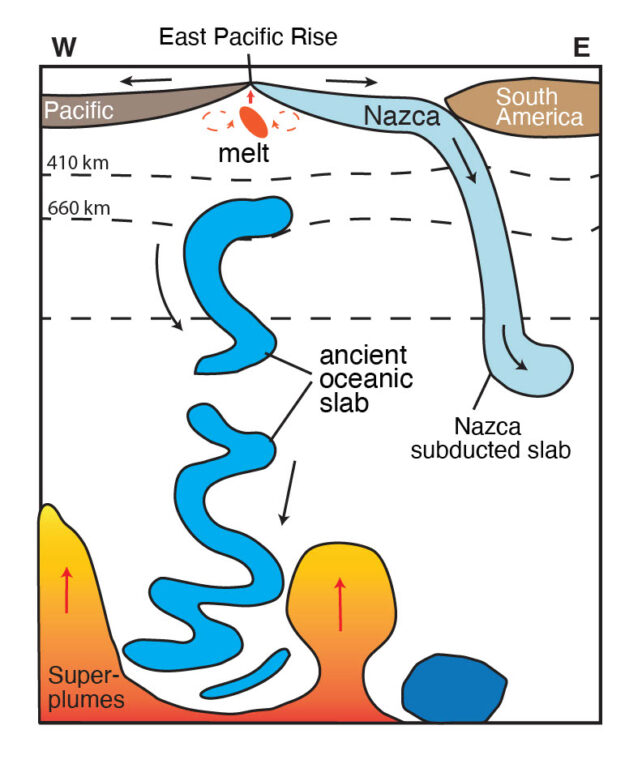ARTICLE AD
 Example of subduction processes in the Atlantic. (Science Photo Library/Getty Images)
Example of subduction processes in the Atlantic. (Science Photo Library/Getty Images)
Scientists have now identified a strange slice of Earth deep below the Pacific that may explain why this region is currently creating the world's fastest spreading ocean ridge – the East Pacific Rise.
Using seismic data, University of Maryland geologist Jingchuan Wang and colleagues have found ancient ocean slabs hiding deep in Earth's interior, which could be contributing to the spread, and they date back to the time of the dinosaurs.
"Our discovery opens up new questions about how the deep Earth influences what we see on the surface across vast distances and timescales," says Wang.
Sending bouncing soundwaves deep into the ground to form seismic maps, Wang and team identified an odd blob of mantle moving surprisingly slow beneath the Nazca Plate that borders South America's own continental plate.
Most of Earth's volume is made up heated silicate rocks sandwiched between a cool, thin outer crust and a scorching hot core. Referred to as the mantle, this partially molten layer of minerals flows in cycles over the very slow course of tens of millions of years due to the extreme temperature differences above and below. Denser, cooler material is drawn into the warmer interior in a process called subduction.
In this area the Nazca Plate is currently subducting beneath South America, as shown in the diagram below. But on the western side of the plate is the rapidly growing ocean ridge and a hotspot of geological activity under the Easter Islands and a mysterious structural gap between the the central and eastern Pacific.
 Diagram of structures under today's Nazca plate. (Wang et al., Science Advances, 2024)
Diagram of structures under today's Nazca plate. (Wang et al., Science Advances, 2024)"We found that in this region, the material was sinking at about half the speed we expected, which suggests that the mantle transition zone can act like a barrier and slow down the movement of material through the Earth," explains Wang.
The team determined this slab structure is colder and denser than the surrounding regions and it appears to be a fossilized chunk of an ancient seafloor.
"This thickened area is like a fossilized fingerprint of an ancient piece of seafloor that subducted into the Earth approximately 250 million years ago," Wang describes. "It's giving us a glimpse into Earth's past that we've never had before."
By not melting as completely as the surrounding mantle, the remnants of what had once been a Triassic ocean floor protrude deeper into the hotter mantle layers, causing the material to bulge into structures called super plumes.
The Easter hot spot is thought to sit above one of these plumes.
"Geodynamic simulations have attributed the geometry and stability of the lower mantle structures to their direct interactions with subducting slab," the team write in their paper.
The researchers suspect this series of anomalies, which orient from east to west, may help tell the story of the Nazca Plate, and how it has moved throughout Earth's history.
By deciphering historic traces of these ancient impacts deep within the ground, geologists can learn more about how our planet's inner workings shape the surface of our world today.
"Seeing the ancient subduction slab through this perspective gave us new insights into the relationship between very deep Earth structures and surface geology, which were not obvious before," explains Wang.
This research was published in Science Advances.

 1 month ago
20
1 month ago
20 

